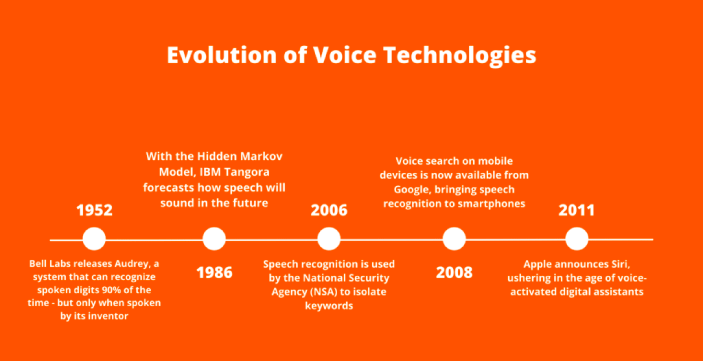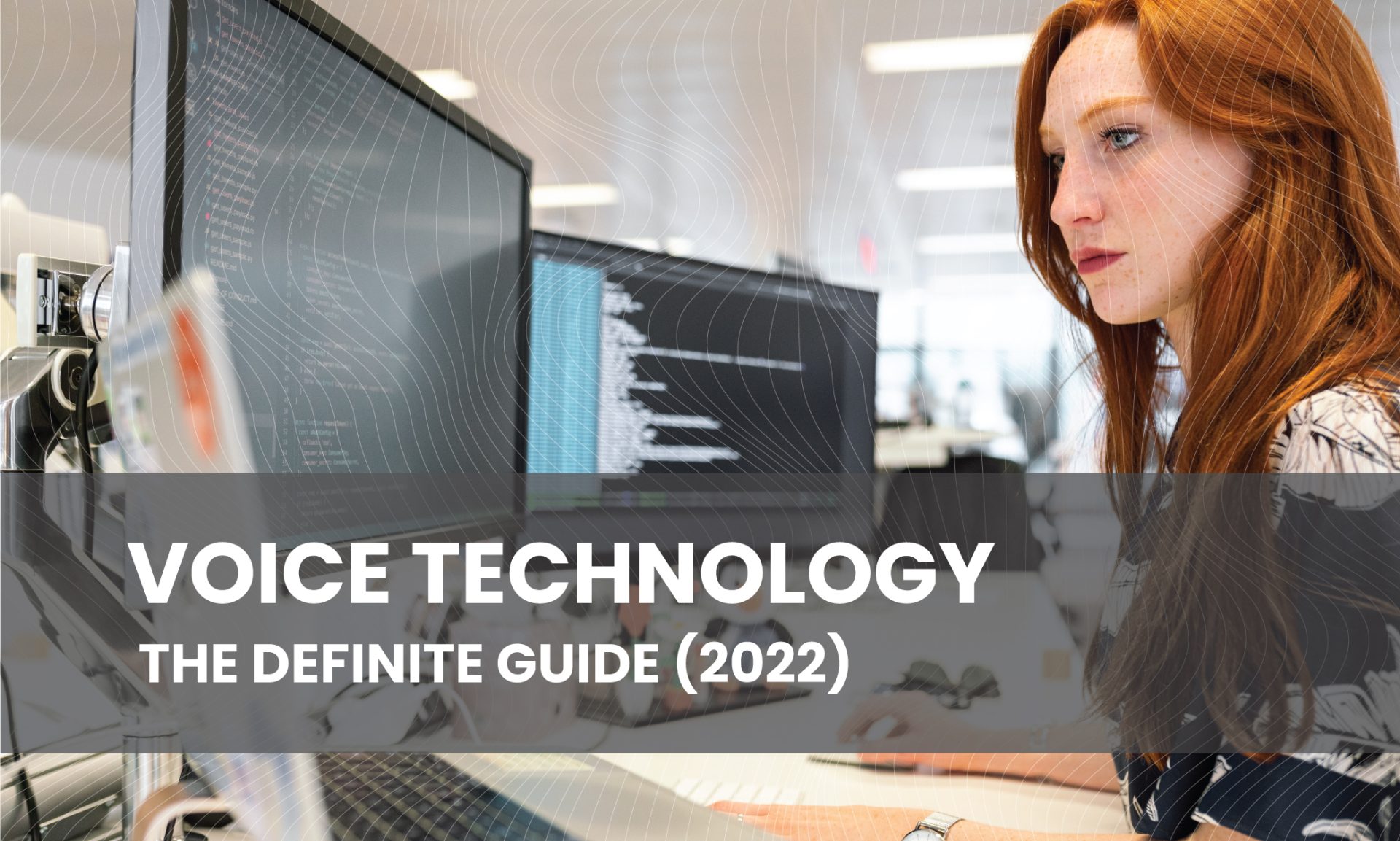Introduction
In this article, we will be discussing all voice technologies.
After reading this article, you will be able to understand
- Why voice technology is popular
- How do we implement voice technology into our business
- Different types of voice technologies that are prevalent in 2021
- The challenges that are faced by Voice technology today, and
- What’s in the future for voice technologies
Let’s begin!
Evolution and current trends of voice technology
The first speech recognition systems were focused on numbers, not words.
In 1952, Bell Laboratories designed“Audrey”, a system that could recognize single spoken digits. Ten years later, IBM introduced “Shoebox” which understood and responded to 16 words in English.
The ‘80s saw speech recognition vocabulary go from a few hundred words to several thousand. One of the breakthroughs came from a statistical method known as “Hidden Markov Models” (HMMs).
Instead of just using words and looking for sound patterns, HMMs estimated the probability of the unknown sounds corresponding to given words.
Later came personal voice assistant systems. Those apps put speech recognition into the hands of millions of people, boosted by processing power now offloaded to huge data centres.
Google was collecting data from billions of searches which could help it predict what a person is saying and build the new generation of language models.
When we were introduced to voice assistants back in 2011, the potential for many innovations and new ideas started to emerge: new and advanced features were developed and integrated into voice assistants.
New innovative voice tools and technologies are being developed to such an extent. Voice can be used by users through their whole online journey: onboard, search for something, move from page to page, complete surveys … It’s now all very easy to set up!


Why is voice technology popular nowadays?
Voice technologies are around us in our everyday lives!
We can view and interact with them right from the palm of our hands to our favourite customer’s websites.
As voice technologies become a bigger part of the market, they will be a great tool with a lot of opportunities!
There are several reasons why voice technology is becoming so popular.
Here are a few:
Easy to use and interact
The primary reason why voice technologies are popular is that they are easy to use and interact with.
All you need is your voice!
Using your voice, you can interact with any assistant whose AI will find any information you need.
Let’s think of this example. Suppose you want to find any information about any restaurants that are in proximity to you.
All you have to do is just state your question to your voice assistant and voilà, you’ve just got the list of restaurants around you.
Along with voice-assisted guidance that can help you find the restaurant you want to eat in!
Pretty simple, right?


Collect user data in an easier and faster way
It does feel better when someone who we like expresses their thoughts to us right?
Same way, with voice technology, the same thing happens when users talk and have a natural interaction with your website and platform!
That way, you can understand how users feel about your products and services, and more.
You will have a better and clearer understanding of your customers to create and launch new products and services tailored to their needs, and help you make better decisions!
Let’s put this as an example: suppose your sales data shows that your customers like your strawberry cakes more than your chocolate cakes.
You can send in personal voice surveys to your customers so they can complete it with just their voice and you get a clear understanding of your customer’s preferences, which would help you make better decisions.
If you’re still not convinced after this example, check out our voice survey demo right here.
User friendly and easily accessible for people with disabilities
Some people have different needs and technology should not be harder for them to use, which is where voice technology comes in!
Voice technology helps users with typing or seeing difficulties using smartphones and other devices. People can just say a certain hotkey to wake the voice assistant up, ready to support them.
For example, it is understandable that people with Epilepsy and Seizures have difficulties in using their smartphones.
So with voice assistance, users with disabilities can search for any products or information on the web, thus helping them utilize their smartphones with ease.
Check out this video on how Amazon Alexa has proven to be useful for people with disabilities
Get any information you want faster and more easily
Finding any information has never been easier than in today’s generation, especially with the presence of voice assistance technologies.
Users can now ask for any information using just their voice. Voice technology is at a newer level where it can help us find any information faster.
Best of all, it helps provide great recommendations for anything new!
Let’s put this as an example. Imagine you are visiting Paris for the first time and you want to find out what the best tourist attractions around you are.
All you have to do is just trigger your voice assistant and ask your question!
It will then help you discover the best destinations with extra pertinent information like ticket pricing, and much more!
Check out this video of Sundar Pichai, CEO of Google explaining how powerful Google Assistant is
Onboarding your clients and collaborators in an interactive way
When new user enters a platform for the first time, they won’t be as proficient with your platform as more frequent users.
This is where voice technology comes in. With the help of integrated voice assistants, users can be guided and be shown what the important pages and sections in the website are.
Best of all, users can make purchases and even find any important information on the website!
Let’s take an example here.
Imagine you’re visiting a new shopping website and you try to understand the interface of the website. But you find it time-consuming. To say the least, it’s not obvious.
Well, with the help of an integrated voice assistant, you can access and also purchase anything you want naturally using just your voice!
Check out this demo on how integrated voice assistants can help in onboarding a client to a new website.
The 3 Ways To Develop And Implement Voice Technology In Your Business
Now that you know what voice technologies are and why they are popular today, you might be wondering: “ How can I integrate an effective voice strategy into my business?”.
Understandably, voice technology has its power and benefits, and you would want those benefits to profit your businesses.
Developing and integrating voice technology into your business has never been easier in today’s world as there are now three ways to develop and integrate voice technologies into your business.
Native Programming
If your organization has enough resources and talent to develop a voice strategy, a clean and effective voice strategy can be developed in any manner you want.
There are many programming languages used in developing a voice strategy for your business but the most common and preferred programming languages are C++, Python, Java and more!
As voice technology becomes increasingly prevalent, many small businesses turn to tech giants like Google or Amazon for assistance in terms of data and more.
In contrast, organizations with a large number of resources and power implement voice technologies with their own resources and strategies
Via voice agency
Developing a voice strategy natively is often an expensive approach as you need to have the necessary tools and the talent strong enough to create an effective voice strategy.
What if you could provide the responsibility of developing a voice strategy to a group of people who already have the necessary tools and talent required to develop an effective voice strategy?
Well, let me introduce voice agencies.
A voice agency is a company that helps businesses and organizations integrate voice technologies into their operations.
By simply approaching a voice agency with all of your goals and objectives, the agency, with the help of its programmers and developers, would develop an effective voice strategy for your business.
There are many voice agencies around the world (RAIN, Speak UX, …), that can help you in developing voice strategies for your business!
If you don’t know where to find some or how to pick the best one for you, check out our blog post on the topic here.
No Code Tools
Everywhere around us, no-code tools are on the rise. There are no-code tools to build websites and apps and even automate certain business processes.
But what if I told you that you could integrate voice technology in your business without the need for code at all? Well, there it is!
With the help of no-code tools like Vocads, you can develop a successful voice strategy for your business without the need to code! Simply connect one or more elements, import the embedding script into your website database and there you go: you have just implemented voice technology in your business in less time and effort!
The 8 Most Prevalent Types Of Voice Technologies In 2022
Now that we understand how voice technology is popular and how to develop and integrate voice technology into your business.
But what kinds of voice technologies are present now?
It’s important to have a basic understanding of the different types of voice technologies that are present in today’s generation.
Let’s go and find out the main sorts of voice technologies available in 2022.
Speech to Text / Text to Speech
The technology behind speech-to-text software translates audio content into written words.
Those who need to create a lot of written content but don’t want to spend a lot of time typing can benefit a lot from speech recognition software. As well as for people with disabilities that make it difficult for them to use a keyboard, it is useful for them.
The text-to-speech (TTS) process converts text into speech for audio transmission. TTS is a natural language modelling process.
It is the opposite of speech to text, where technology records spoken words accurately as text.
Today, text-to-speech is common in technologies that provide audio output from digital text to assist people who are unable to read or simply rather listen than look.
Some of the best examples of speech-to-text/text-to-speech tools would be Dragon Anywhere by Nuance Technologies, IBM Watson and Murf.ai
If you’d like to see a demo, check out IBM Watson’s text-to-speech technology demo.
Mobile Voice Assistance
Voice assistants and Intelligent Voice Assistants (IVA) are digital assistants that use voice recognition, language processing algorithms, and speech synthesis to listen to voice commands and return relevant information or perform specific tasks as requested by the user.
By filtering out background noise and listening for specific keywords, voice assistants can return relevant information based on specific commands, sometimes called intents.
Many mobile applications provide voice assistants around us. Some of the most popular ones would be Siri by Apple and Google Assistant by Google.
Here is a simple example of how mobile voice assistants work
Voice Home Assistants
Surely we have come across this a lot of times. Voice Home Assistants are standard Voice Assistants embedded in devices spread around your house (like Google Homes) and control smart systems in your property.
These software/products can be integrated with various other applications that manage our homes with the power of our voice.
They can also be integrated with various skillsets to provide a better and richer user experience.
The most popular voice home assistants are Google’s Nest and Amazon’s Echo.
If you’d like to see voice home assistants in action, here is a short video demo.
Automobile Voice Assistants
In-car voice assistants empower users to control certain functions while driving or in the vehicle. their car.
In-car voice assistants help users perform many different tasks such as calling a friend, playing or changing media such as music, and videos, shifting to different driving modes, and more all by just using their voice!
This helps users to concentrate on the road and leave their smartphones untouched while driving.
Many automobile companies develop their in-car voice assistants while agencies like Cerence Drive and Houndify build their business on this.
Check out Houndify’s demo on how automobile voice assistants work.
Educational voice assistants
Educational voice assistants are voice assistants that help students and children educate themselves.
With the help of educational voice assistants, children and students can easily understand any concept and enhance their skills!
These kinds of voice assistants reach their full potential when learning languages, practising speech and more!
While some language training applications like Duolingo have their integrated voice assistants, other companies like Soapbox Labs have developed voice assistants for educating and teaching children in general!
Here is a small demo of how Soapbox Labs works with children
Voice Biometrics
A voice biometric system verifies the speaker’s identity through their voice. This type of technology entails recognition, speaker recognition, voice printing, voice authentication, and others.
The term voice biometrics is used to simplify things. Rather than the words we utter, voice biometrics recognizes specific speakers. Our anatomy and behavioural speaking patterns determine the distinctive qualities of each of our voices.
Our voices are shaped by the shape and size of our mouths and throats, as well as our language, pitch, and speaking patterns (for example, fast-talking versus slow-talking).
Similar to in-car assistants, most voice biometric systems are natively developed to ensure that their systems don’t get compromised, but there are voice agencies like Cerence Drive, DTec and Pingloud that help develop voice biometrics solutions for your business.
Check out this demo by DTec to understand and learn more about voice biometrics
Medical Voice Assistance
Medical voice assistants help in simplifying management for doctors and nurses in hospitals, clinics and more.
These systems help remind patients to take their medication, provide information about possible conditions when users list down any symptoms they are facing, help simplify paperwork, prescription work for doctors, and more.
Most medical-based voice assistants come as applications or integrations for home-based voice assistants like Alexa, and Google Assistant, while companies like Suki develop easy voice-based solutions for healthcare and more.
If you would like to see a detailed explanation of how AI and Voice Technology help transform healthcare, check out this video
Website Voice Assistants
What if I told you that you can now access and explore websites using just your voice? What if you can be redirected to different web pages in a website just by using your voice?
Well, you can now with the help of website voice assistants!
These types of assistants help users like you navigate a website, which is especially useful for first-time visitors who don’t know where to go.
These assistants also help in onboarding new clients or collaborators, and most importantly, provide a better user experience.
Vocads is one of the companies involved in developing Website Voice Assistants. They provide a no-code tool to easily create website voice assistants by just connecting a few blocks. You can integrate your new voice flow into your website immediately without any hassle.
Check out their video on how website voice assistants are developed and how it functions
Challenges Faced By Voice Technologies Today
It’s like the saying that always goes “There are always two sides to every coin”.
Even though voice technologies are proven to be powerful and useful to our generation, there still are challenges and setbacks holding it back from exerting its full potential.
Privacy Issues
Voice-activated technologies offer many exciting features, but they also expose the personal information of users to third parties.
Consumers should therefore be aware of the privacy concerns regarding voice recognition technologies.
Due to the popularity of several devices, users are constantly encouraged to share personal information.
Devices do not send everything they can hear to their company as proven multiple times by experts checking the signals sent on the network. However, it is true that, by using voice assistants more and more, we voluntarily say more things that involuntarily reveal more about our lives.
It’s like that friend to who everybody tells their secrets when drunk. Even though this friend never has a full description of everybody’s lives, they can easily link the pieces together to have a pretty accurate picture
Background Noise
The background dim of multiple speakers or noise in surrounding environments makes it difficult to communicate during video or audio conferencing, while in a car, on a cell phone, or when talking to your digital assistant.
An effective voice interaction experience needs reliable noise filtering, voice recognition and voice enhancement technology.
Voice Recognition for children
Children’s speech behaviour is not just more variable than that of adults, but wildly unpredictable as well.
Children over-enunciated words, elongate certain syllables, punctuate each word as they think aloud or skip some words entirely. As adults, we know how to use these devices effectively and how to elicit the best response.
As we grow up, we formulate our requests in our minds, modify them based on learned behaviours, and when we speak our requests out loud to Alexa.
When kids ask Siri or Alexa unthought out questions, more often than not they are given an erroneous or canned response.
Imprecision and false interpretations
Despite its ability to recognize spoken words, voice technology isn’t always accurate.
It’s because computers are not capable of understanding the contextual relationship between words and sentences, resulting in misinterpretations of what the speaker was attempting to convey.
This issue can be observed easily when a person with an accent tries to speak to the AI in English. The different way of interpreting certain words throws the AI off of its game…
In comparison to humans, speech recognition systems lack millennia of contextual experience, while VUIs encounter difficulties when trying to understand the meaning of a sentence.
What’s In The Future For Voice Technology?
So far we have discussed the types, potential and challenges of voice technology.
But what about the future? What’s in the store for voice technologies in the coming years?
Let’s find out!
Individualized Experience
The best voice technologies are those that identify and provide options and services that are tailored to different people. Right?
Well, that’s true! Providing individualized experience is one of the goals that many voice assistant companies are trying to provide.
Providing a unique and new unique individual experience would help the voice assistant provide better for the user.
Touchless Interaction
Touchless interaction happens when we can use voice assistants without turning our phones on or accessing an application.
Although this technology is present in our lives, it isn’t as perfect as we need it to be as it triggers at moments when we don’t need it and sometimes doesn’t turn on when we do.
This technology would help people with disabilities and more to use their phones in a better way.
Faster and Better Integration
Gone are the days where you would have to wait days or months to integrate voice assistants or enable voice strategy for your business.
With the rise of no-code tools, integrating voice strategy into your business has never been easier.
No code tool like Vocads helps you build an effective voice strategy for your business. You can integrate the same voice strategy for your website or platform in less than a minute!
Impressive isn’t it?
Security Focused
Addressing the user’s privacy concerns is key to spreading voice technology.
Now companies like Microsoft are developing and providing better solutions to help voice assistants be more secure in terms of data and privacy.
Easier development and integration
With the rise of no-code tools, it is easier to develop any internet-related resources like websites and tools like chatbots and more.
With no-code tools like Vocads, you can develop and integrate an effective voice strategy for your business by simply dragging and dropping certain elements and connecting them!
Conclusion
With the help of voice technologies, everyone can benefit from its multiple advantages.
Even though voice technologies have some setbacks. Much research and developments are happening as we speak for voice assistants and technologies to perform better for humans in
What about you? Have you learnt something new? Let us know in the comments below
Also, consider sharing this article and subscribe to our email newsletter for more information regarding voice technologies!


